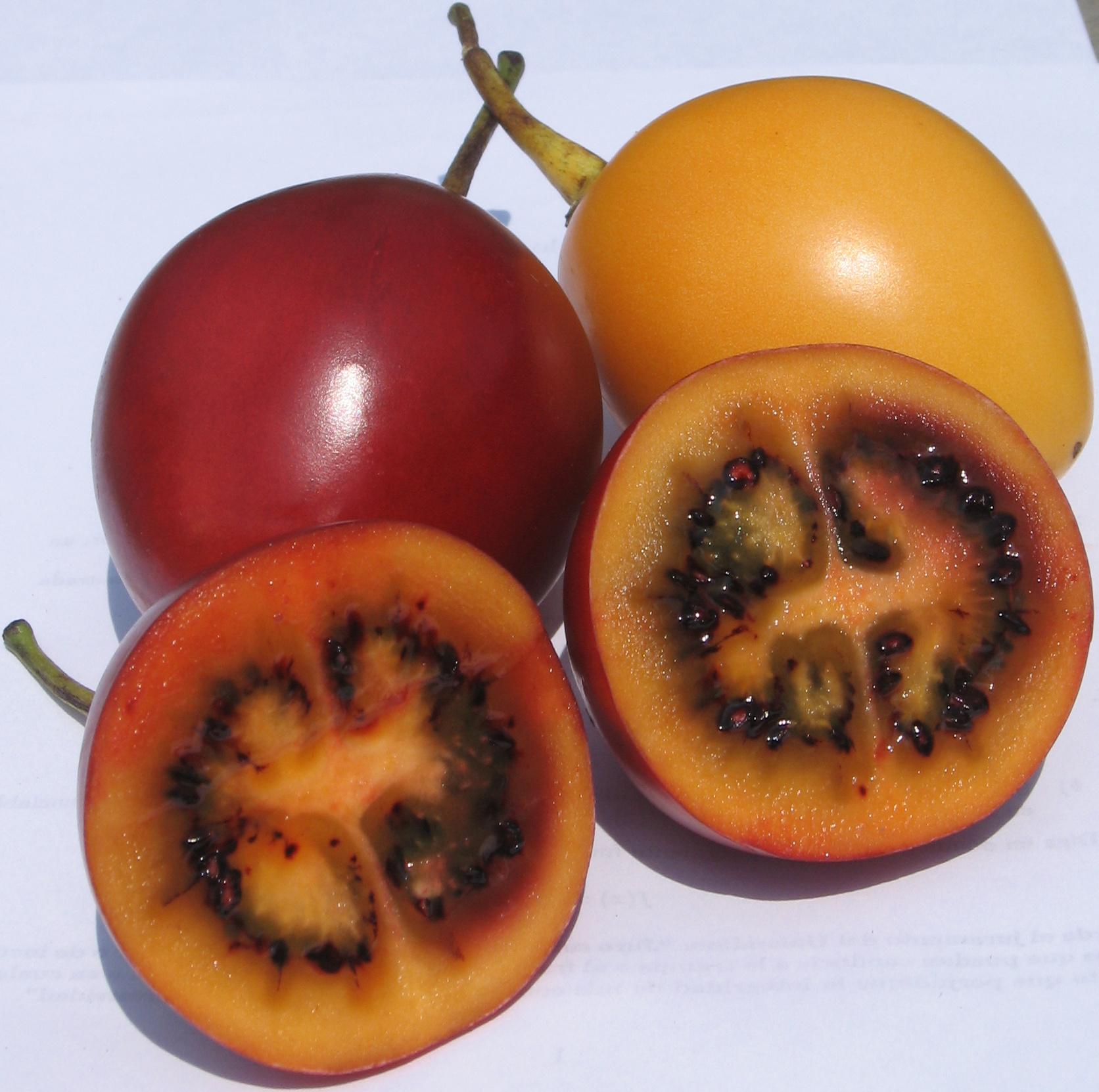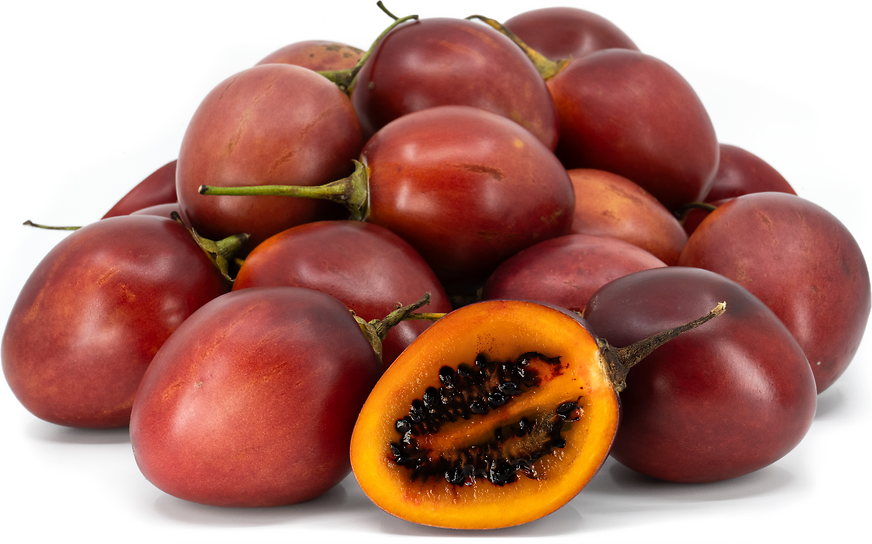Tamarillo
Tamarillo (Solanum betaceum )
The tamarillo or tree tomato ( Solanum betaceum, Syn Cyphomandra betacea ) is a species of the genus Solanum. The tamarillo is known mainly through the small, egg-shaped red or yellow fruit, because of it is cultivated.
Description
Habit
Tamarillo are small, two to seven meters high, evergreen trees, whose trunks are densely pubescent with unbranched glandular trichomes and undrüsigen. The trunk branches sympodial by most four, more rarely, after three leaf approaches. The paper-like leaves are to 3-25 cm long petioles, the length of the leaves may correspond to the width or up to 1.5 -fold range, the size is in the range 7-40 × 6-35 cm. The shape of the leaves ovate, auriculate to cordate at the base, so that 1.5 to 6 cm long lobes arise, the leaf tip is pointed, the margin is entire. The pubescence of the leaves is on the achszugewandten ( adaxalen ) page sparser than on the achsabgewandten ( abaxial ) side, only on the leaf veins and the petiole is also the hair thicker. The roots do not penetrate very far into the ground a ( shallow roots ).
Inflorescences and flowers
The branched or unbranched inflorescences are 2.5 to 15 cm long and consist of ten to 50 hermaphrodite flowers, the shoulders are slightly to strongly hairy. The peduncle has a length of 1.5 to 9 cm, the leaf stem is 2-8 cm long and the flower stems have during flowering a length of 10 to 20 mm, are long in fruit maturity between 15 and 50 mm and are about 3 to 10 mm apart. Above the base of the flower stems are clearly divided, so that the rest of the flower stalk has a length of only 1 to 3 mm.
The five petals initially develop as ellipsoid to ovoid buds with blunt to pointed tip. In the heyday of the Goblet has a radius of 3 to 5 mm, triangular calyx lobes 1-2 × 2-3 mm, fleshy, dull to cut off, pointed at the tip and sparsely hairy to densely. The corolla is pink - whitish, almost leathery to fleshy, has a diameter of 2 to 2.5 cm. The corolla tube is about 2 to 3 mm long, adjoining the corolla tube Kronlappen are narrow and pointed triangular, glabrous, tomentose on the edge, on the basis of 2.5 to 4 mm wide and 7-12 mm long.
The racks of pale yellow anthers are each about 5 to 6 × 2 to 2.5 mm long and lanceolate. They open by pores, the adaxial ( facing the axis ) and distal to (at the end of the anther ). The connective -called sterile middle part of the anther is bright lemon yellow, 4.5 to 5 × 1-2 mm long, narrowly triangular. It is on the abaxial ( achsabgewandten ) side slightly shorter than the tips of the theca at the base are both in about the same length or the counter tops are a little longer on the adaxial ( achszugewandten ) page is missing the connective. The pollen grains are oval and three-lobed, have a grainy surface and exhibit a wide variety of fine sting on. The ovary is smooth, the pen is also hairless, cylindrical, 5-6 × 0.5 to 1 mm in size and is thus also about 1 to 2.5 mm above the stamens. The scar is being supported. Nectaries are absent.
The corollas are usually open around noon, in the evening the petals envelop again the anthers and the stylus, which is then repeated for another two to three days until the flower closes for the last time. Fertilized flowers finish this cycle usually something rather than unfertilized. The popping of the anthers occurs later than simultaneously with the opening of the corolla, usually a bit more. Here, the pollen is not released immediately, but secreted in touch or pressure through a pore at the tip of the anther in a pollen cloud. The probability of fertilization of the stylus rises a few days before the opening of the flower and then decreases from the first day after first opening of the flower within five to eight days.
About the pollination strategy and the original pollinators of the species is poorly understood, it is believed that it becateum in Solanum is a plant with " Pollen Bee " is not, as in other closely related species to " perfume flowers ", mainly of male bees of the tribe Euglossini be visited because of separate from flower fragrances. Observations on pollinators, there are cultured specimens from New Zealand, where the Western Honey Bee (Apis mellifera), the dark earth bumblebee (Bombus terrestris ) and the Garden Bumblebee (Bombus hortorum ) visiting the flowers.
Fruits
The yellow to orange, red or purple fruits two-chamber berries with a size 4-10 × 3-5 cm, which are ellipsoid or ovoid, have a flattened or pointed tip, often have darker horizontal stripes are not hairy and some stone cells have can. They feature a flattened, hairy seeds with a size of 3 to 4 × 3.5 to 4 mm.
Tamarillobäume reach an age of three to four years, the first flower is formed in the first branch of the shoot in about 1 to 1.5 m in height at the age of eight to ten months.
Occurrence and Habitat
For a long time there were no wild populations of the tamarillo known, but since the late 1960s reported single botanist of populations that should occur wild in the south of Bolivia and the opposite regions of northwestern Argentina. Some botanical expeditions that took place between 1998 and 2000 were able to show that it is most likely in these populations is wild specimens of the species and not feral, originally cultivated plants. Morphologically there are no differences between the wild and cultured specimens of the species, indicating a far past cultivation, probably around the time of the arrival of Christopher Columbus in America.
Tamarillo grow best in areas with temperatures between 18 and 22 ° C, having an annual rainfall of 600 to 800 mm. This roughly corresponds to the climatic conditions, as they occur at an altitude 1800-2000 m in the Andes. In short frosts younger branches and leaves of the plant die off, but the frost does not last for a long time, survive the stronger branches and the main stem of the plant. At high temperatures and longer dry periods affect flowering and fruit set.
System
Molecular Biology research shows that the species within the genus Solanum (Solanum ) is classified in the so-called " Cyphomandra clade ". In addition to the species of the former genus Cyphomandra It contains the Solanum sections pachyphylla, Cyphomandropsis and glaucophyllum. Characteristics that have all kinds in common within the Cyphomandra - clade are woody, shrubby or tree-like habit and often enlarged, or clearly distinct anther- connectives or Antherenunterseiten. So far, strikingly large chromosomes was found also in all species studied. The relations to other clades within the genus is still unknown.
Cultivation and use
Although the origins of the species in the south of Bolivia and northwestern Argentina are, the main distribution area is now in northwestern South America. Was introduced, the plant in Central America, Mexico and the Caribbean. However Comercial main growing area is New Zealand, where varieties and hybrids with closely related species such as Solanum maternum, Solanum roseum and Solanum unilobum be made. 1993 were used for the cultivation of tamarillo, of which about 2000 tons of fruit could be harvested in New Zealand about 200 acres of land. 87 % of New Zealand's exports went to the United States.
Furthermore, the tamarillo in Spain, Portugal, France, Great Britain, the Netherlands, Italy, the Canary Islands, Ghana, Ethiopia, DR Congo, Uganda, Tanzania, Zimbabwe, South Africa, India, Sri Lanka, Bhutan, Sumatra, Java, New Guinea is, New Caledonia, Australia and grown in the USA.
The fruits are eaten mainly in Latin America in the raw and cooked state, but the outer skin have an unpleasant taste and can be somewhat fixed. The outer layer of juicy fruit flesh can be a bit bland and tasteless, but the inner pulp that surrounds the seeds is also edible, soft, juicy and süßherb.
Besides the use as a fruit, in which the tamarillo can be eaten half and sweetened with a spoon, other uses are widespread: When filling or side dish to meat, in spreads and various desserts, as a jam or chutneys.
The fruits contain 82.7 to 87.8 % water, 1.5 % protein, 10.3% carbohydrates and 0.06 to 1.28 % fat. They also contain vitamins A, B6, C and E as well as iron as a trace element.
The leaves of the plant are used in the Ecuadorian folk medicine as a remedy for sore throat.
Etymology
The fruits are mostly " tomate de árbol " ( Spanish), " tomate de árvore " ( Portuguese) or "tree tomato" (English) called what the German term " tree tomato" is roughly equivalent to. The term " Tamarillo " was introduced with the cultivation in New Zealand, but has no other meaning itself.
The Style epithet " betaceum " derives from the Latin betaceus what was in late Latin the name of beetroot (Beta vulgaris) and refers to the color of the fruit. The former genus name " Cyphomandra " derives from the Greek kyphoma ( hump, hump ) and recognized ( genitive andros ) and has the thickened connective of male flower organs out ( anthers ).
Botanical history
The species was first described in 1799 by Antonio José Cavanilles as Solanum betaceum. 1845 transferred Otto Sendtner the species in its own genus called Cyphomandra, in the last about 40 species were classified.
Only in 1995 the genus by Lynn Bohs again with the nightshade (Solanum ) was united what was initially not recognized mainly by morphologically working botanists. Meanwhile, the reintegration was confirmed by various molecular biology and is widely recognized.










